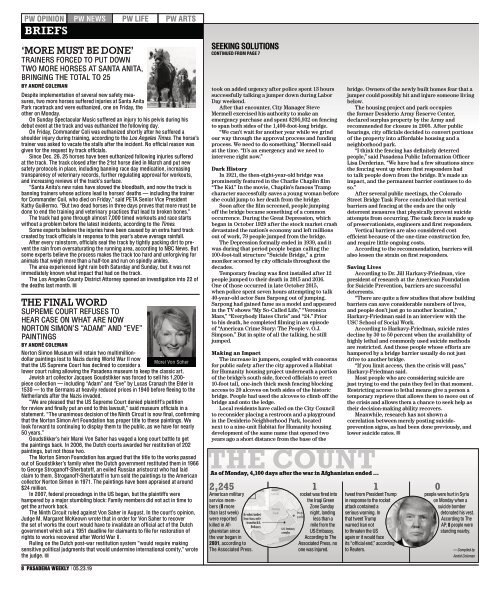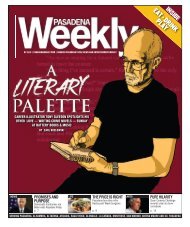05.23.19
Create successful ePaper yourself
Turn your PDF publications into a flip-book with our unique Google optimized e-Paper software.
PW OPINION PW NEWS PW LIFE PW ARTS<br />
BRIEFS<br />
‘MORE MUST BE DONE’<br />
TRAINERS FORCED TO PUT DOWN<br />
TWO MORE HORSES AT SANTA ANITA,<br />
BRINGING THE TOTAL TO 25<br />
BY ANDRÉ COLEMAN<br />
Despite implementation of several new safety measures,<br />
two more horses suffered injuries at Santa Anita<br />
Park racetrack and were euthanized, one on Friday, the<br />
other on Monday.<br />
On Sunday Spectacular Music suffered an injury to his pelvis during his<br />
debut event at the track and was euthanized the following day.<br />
On Friday, Commander Coli was euthanized shortly after he suffered a<br />
shoulder injury during training, according to the Los Angeles Times. The horse’s<br />
trainer was asked to vacate the stalls after the incident. No official reason was<br />
given for the request by track officials.<br />
Since Dec. 26, 25 horses have been euthanized following injuries suffered<br />
at the track. The track closed after the 21st horse died in March and put new<br />
safety protocols in place, including banning race day medication, increasing<br />
transparency of veterinary records, further regulating approval for workouts,<br />
and increasing reviews of the track’s surface.<br />
“Santa Anita’s new rules have slowed the bloodbath, and now the track is<br />
banning trainers whose actions lead to horses’ deaths — including the trainer<br />
for Commander Coil, who died on Friday,” said PETA Senior Vice President<br />
Kathy Guillermo. “But two dead horses in three days proves that more must be<br />
done to end the training and veterinary practices that lead to broken bones.”<br />
The track had gone through almost 7,000 timed workouts and race starts<br />
without a problem before the latest incidents, according to the Times.<br />
Some experts believe the injuries have been caused by an extra hard track<br />
created by track officials in response to this year’s above average rainfall.<br />
After every rainstorm, officials seal the track by tightly packing dirt to prevent<br />
the rain from oversaturating the running area, according to NBC News. But<br />
some experts believe the process makes the track too hard and unforgiving for<br />
animals that weigh more than a half-ton and run on spindly ankles.<br />
The area experienced light rain both Saturday and Sunday, but it was not<br />
immediately known what impact that had on the track.<br />
The Los Angeles County District Attorney opened an investigation into 22 of<br />
the deaths last month. n<br />
THE FINAL WORD<br />
SUPREME COURT REFUSES TO<br />
HEAR CASE ON WHAT ARE NOW<br />
NORTON SIMON’S “ADAM” AND “EVE”<br />
PAINTINGS<br />
BY ANDRÉ COLEMAN<br />
Norton Simon Museum will retain two multimilliondollar<br />
paintings lost to Nazis during World War II now<br />
Marei Von Saher<br />
that the US Supreme Court has declined to consider a<br />
lower court ruling allowing the Pasadena museum to keep the classic art.<br />
Jewish art collector Jacques Goudstikker was forced to sell his 1,200-<br />
piece collection — including “Adam” and “Eve” by Lucas Cranach the Elder in<br />
1530 — to the Germans at heavily reduced prices in 1940 before fleeing to the<br />
Netherlands after the Nazis invaded.<br />
“We are pleased that the US Supreme Court denied plaintiff’s petition<br />
for review and finally put an end to this lawsuit,” said museum officials in a<br />
statement. “The unanimous decision of the Ninth Circuit is now final, confirming<br />
that the Norton Simon Art Foundation has proper title to these paintings. We<br />
look forward to continuing to display them to the public, as we have for nearly<br />
50 years.’’<br />
Goudstikker’s heir Marei Von Saher has waged a long court battle to get<br />
the paintings back. In 2006, the Dutch courts awarded her restitution of 202<br />
paintings, but not those two.<br />
The Norton Simon Foundation has argued that the title to the works passed<br />
out of Goudstikker’s family when the Dutch government restituted them in 1966<br />
to George Stroganoff-Sherbatoff, an exiled Russian aristocrat who had laid<br />
claim to them. Stroganoff-Sherbatoff in turn sold the paintings to the American<br />
collector Norton Simon in 1971. The paintings have been appraised at around<br />
$24 million.<br />
In 2007, federal proceedings in the US began, but the plaintiffs were<br />
hampered by a major stumbling block: Family members did not act in time to<br />
get the artwork back.<br />
The Ninth Circuit ruled against Von Saher in August. In the court’s opinion,<br />
Judge M. Margaret McKeown wrote that in order for Von Saher to recover<br />
the set of works the court would have to invalidate an official act of the Dutch<br />
government which set a 1951 deadline for claimants to file for restoration of<br />
rights to works recovered after World War II.<br />
Ruling on the Dutch post-war restitution system “would require making<br />
sensitive political judgments that would undermine international comity,” wrote<br />
the judge. n<br />
SEEKING SOLUTIONS<br />
CONTINUED FROM PAGE 7<br />
took on added urgency after police spent 13 hours<br />
successfully talking a jumper down during Labor<br />
Day weekend.<br />
After that encounter, City Manager Steve<br />
Mermell exercised his authority to make an<br />
emergency purchase and spent $295,932 on fencing<br />
to span both sides of the 1,400-foot-long bridge.<br />
“We can’t wait for another year while we grind<br />
our way through the approval process and funding<br />
process. We need to do something,” Mermell said<br />
at the time. “It’s an emergency and we need to<br />
intervene right now.”<br />
Dark History<br />
In 1921, the then-eight-year-old bridge was<br />
prominently featured in the Charlie Chaplin film<br />
“The Kid.” In the movie, Chaplin’s famous Tramp<br />
character successfully saves a young woman before<br />
she could jump to her death from the bridge.<br />
Soon after the film screened, people jumping<br />
off the bridge became something of a common<br />
occurrence. During the Great Depression, which<br />
began in October 1929 after the stock market crash<br />
devastated the nation’s economy and left millions<br />
out of work, 79 people jumped from the bridge.<br />
The Depression formally ended in 1939, and it<br />
was during that period people began calling the<br />
100-foot-tall structure “Suicide Bridge,” a grim<br />
moniker scorned by city officials throughout the<br />
decades.<br />
Temporary fencing was first installed after 12<br />
people jumped to their death in 2015 and 2016.<br />
One of those occurred in late October 2015,<br />
when police spent seven hours attempting to talk<br />
40-year-old actor Sam Sarpong out of jumping.<br />
Sarpong had gained fame as a model and appeared<br />
in the TV shows “My So-Called Life,” “Veronica<br />
Mars,” “Everybody Hates Chris” and “24.” Prior<br />
to his death, he completed filming in an episode<br />
of “American Crime Story: The People v. O.J.<br />
Simpson.” But in spite of all the talking, he still<br />
jumped.<br />
Making an Impact<br />
The increase in jumpers, coupled with concerns<br />
for public safety after the city approved a Habitat<br />
for Humanity housing project underneath a portion<br />
of the bridge’s south side, forced officials to erect<br />
10-foot tall, one-inch thick mesh fencing blocking<br />
access to 20 alcoves on both sides of the historic<br />
bridge. People had used the alcoves to climb off the<br />
bridge and onto the ledge.<br />
Local residents have called on the City Council<br />
to reconsider placing a restroom and a playground<br />
in the Desiderio Neighborhood Park, located<br />
next to a nine-unit Habitat for Humanity housing<br />
development of the same name that opened two<br />
years ago a short distance from the base of the<br />
THE COUNT<br />
As of Monday, 4,100 days after the war in Afghanistan ended …<br />
2,245<br />
American military<br />
service members<br />
(0 more<br />
than last week)<br />
were reported<br />
killed in Afghanistan<br />
since<br />
the war began in<br />
2001, according to<br />
The Associated Press.<br />
1<br />
rocket was fired into<br />
the Iraqi Green<br />
Zone Sunday<br />
night, landing<br />
less than a<br />
mile from the<br />
US Embassy.<br />
According to The<br />
Associated Press, no<br />
one was injured.<br />
bridge. Owners of the newly built homes fear that a<br />
jumper could possibly hit and injure someone living<br />
below.<br />
The housing project and park occupies<br />
the former Desiderio Army Reserve Center,<br />
declared surplus property by the Army and<br />
recommended for closure in 2005. After public<br />
hearings, city officials decided to convert portions<br />
of the property into affordable housing and a<br />
neighborhood park.<br />
“I think the fencing has definitely deterred<br />
people,” said Pasadena Public Information Officer<br />
Lisa Derderian. “We have had a few situations since<br />
the fencing went up where first responders had<br />
to talk people down from the bridge. It’s made an<br />
impact, and the permanent barrier continues to do<br />
so.”<br />
After several public meetings, the Colorado<br />
Street Bridge Task Force concluded that vertical<br />
barriers and fencing at the ends are the only<br />
deterrent measures that physically prevent suicide<br />
attempts from occurring. The task force is made up<br />
of preservationists, engineers and first responders.<br />
Vertical barriers are also considered cost<br />
efficient because of the one-time construction fee,<br />
and require little ongoing costs.<br />
According to the recommendation, barriers will<br />
also lessen the strain on first responders.<br />
Saving Lives<br />
According to Dr. Jill Harkavy-Friedman, vice<br />
president of research at the American Foundation<br />
for Suicide Prevention, barriers are successful<br />
deterrents.<br />
“There are quite a few studies that show building<br />
barriers can save considerable numbers of lives,<br />
and people don’t just go to another location,”<br />
Harkavy-Friedman said in an interview with the<br />
USC School of Social Work.<br />
According to Harkavy-Friedman, suicide rates<br />
decline by 30 to 50 percent when the availability of<br />
highly lethal and commonly used suicide methods<br />
are restricted. And those people whose efforts are<br />
hampered by a bridge barrier usually do not just<br />
drive to another bridge.<br />
“If you limit access, then the crisis will pass,”<br />
Harkavy-Friedman said.<br />
Most people who are considering suicide are<br />
just trying to end the pain they feel in that moment.<br />
Restricting access to lethal means give a person a<br />
temporary reprieve that allows them to move out of<br />
the crisis and allows them a chance to seek help as<br />
their decision-making ability recovers.<br />
Meanwhile, research has not shown a<br />
correlation between merely posting suicideprevention<br />
signs, as had been done previously, and<br />
lower suicide rates. n<br />
1<br />
tweet from President Trump<br />
in response to the rocket<br />
attack contained a<br />
serious warning. In<br />
that tweet Trump<br />
warned Iran not<br />
to threaten the US<br />
again or it would face<br />
its “official end,” according<br />
to Reuters.<br />
0<br />
people were hurt in Syria<br />
on Monday when a<br />
suicide bomber<br />
detonated his vest.<br />
According to The<br />
AP, 8 people were<br />
standing nearby.<br />
— Compiled by<br />
André Coleman<br />
8 PASADENA WEEKLY | <strong>05.23.19</strong>
















